Taxation Assignment-1 | Doc
VerifiedAdded on 2022/09/09
|12
|2272
|28
AI Summary
Contribute Materials
Your contribution can guide someone’s learning journey. Share your
documents today.
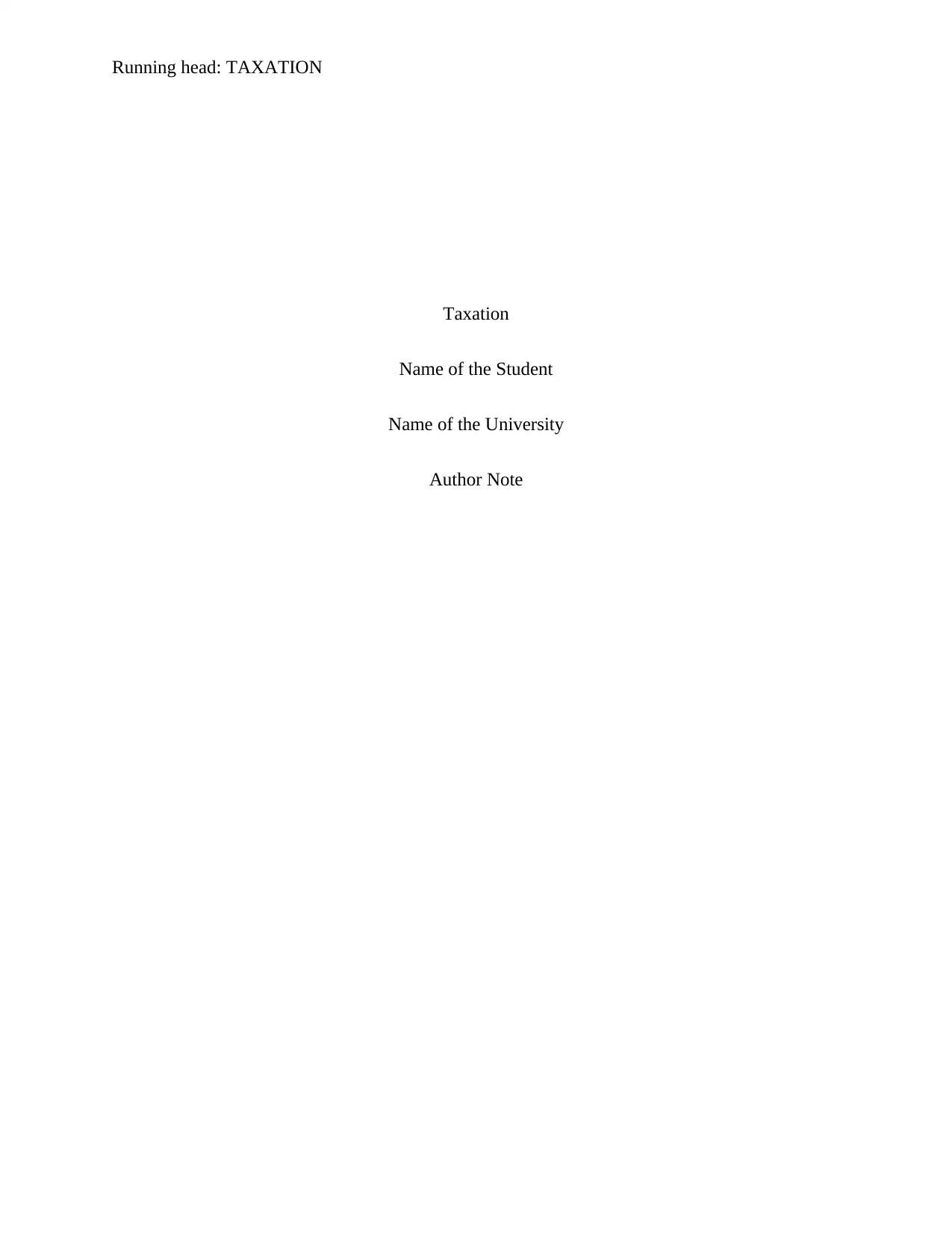
Running head: TAXATION
Taxation
Name of the Student
Name of the University
Author Note
Taxation
Name of the Student
Name of the University
Author Note
Secure Best Marks with AI Grader
Need help grading? Try our AI Grader for instant feedback on your assignments.
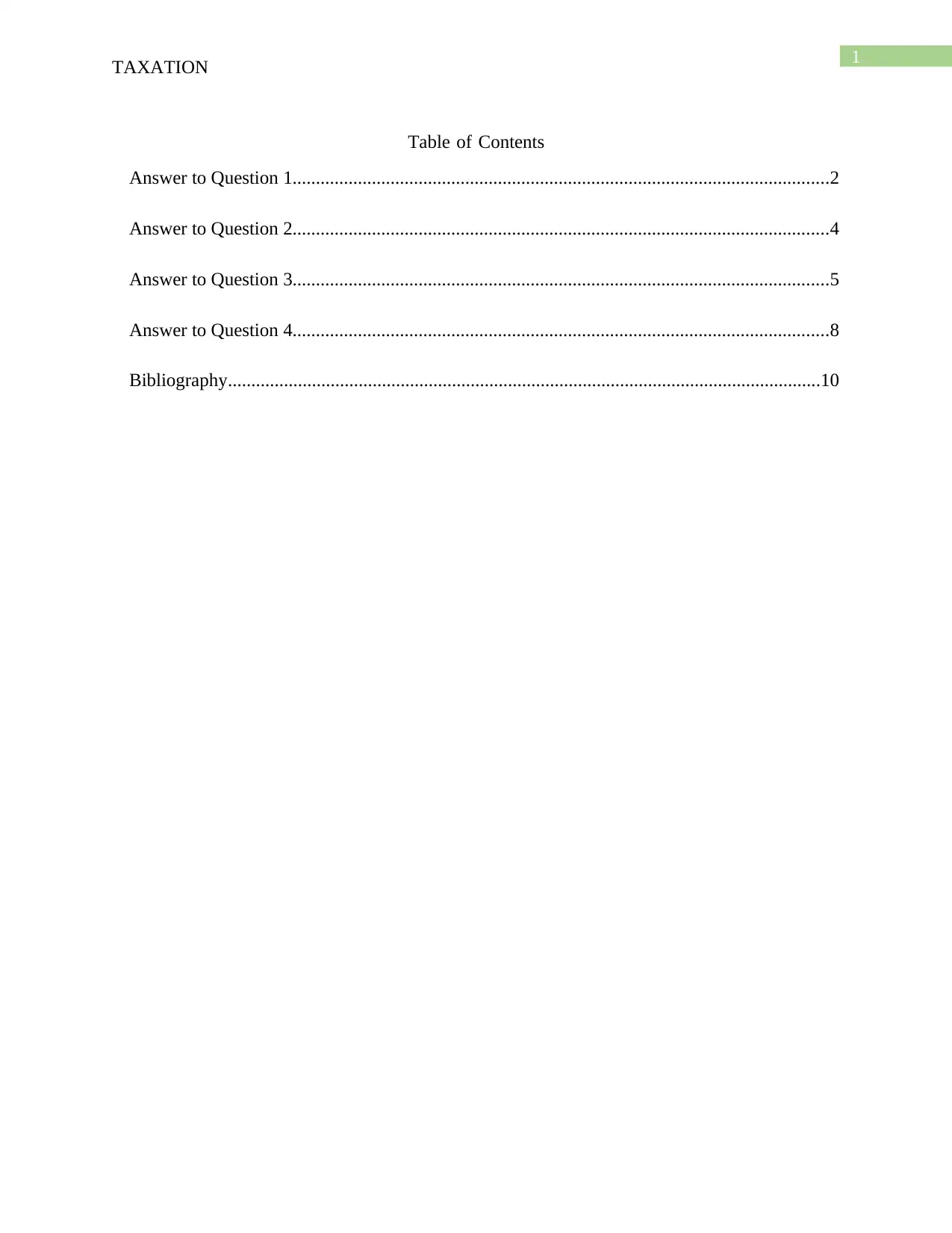
1
TAXATION
Table of Contents
Answer to Question 1...................................................................................................................2
Answer to Question 2...................................................................................................................4
Answer to Question 3...................................................................................................................5
Answer to Question 4...................................................................................................................8
Bibliography...............................................................................................................................10
TAXATION
Table of Contents
Answer to Question 1...................................................................................................................2
Answer to Question 2...................................................................................................................4
Answer to Question 3...................................................................................................................5
Answer to Question 4...................................................................................................................8
Bibliography...............................................................................................................................10
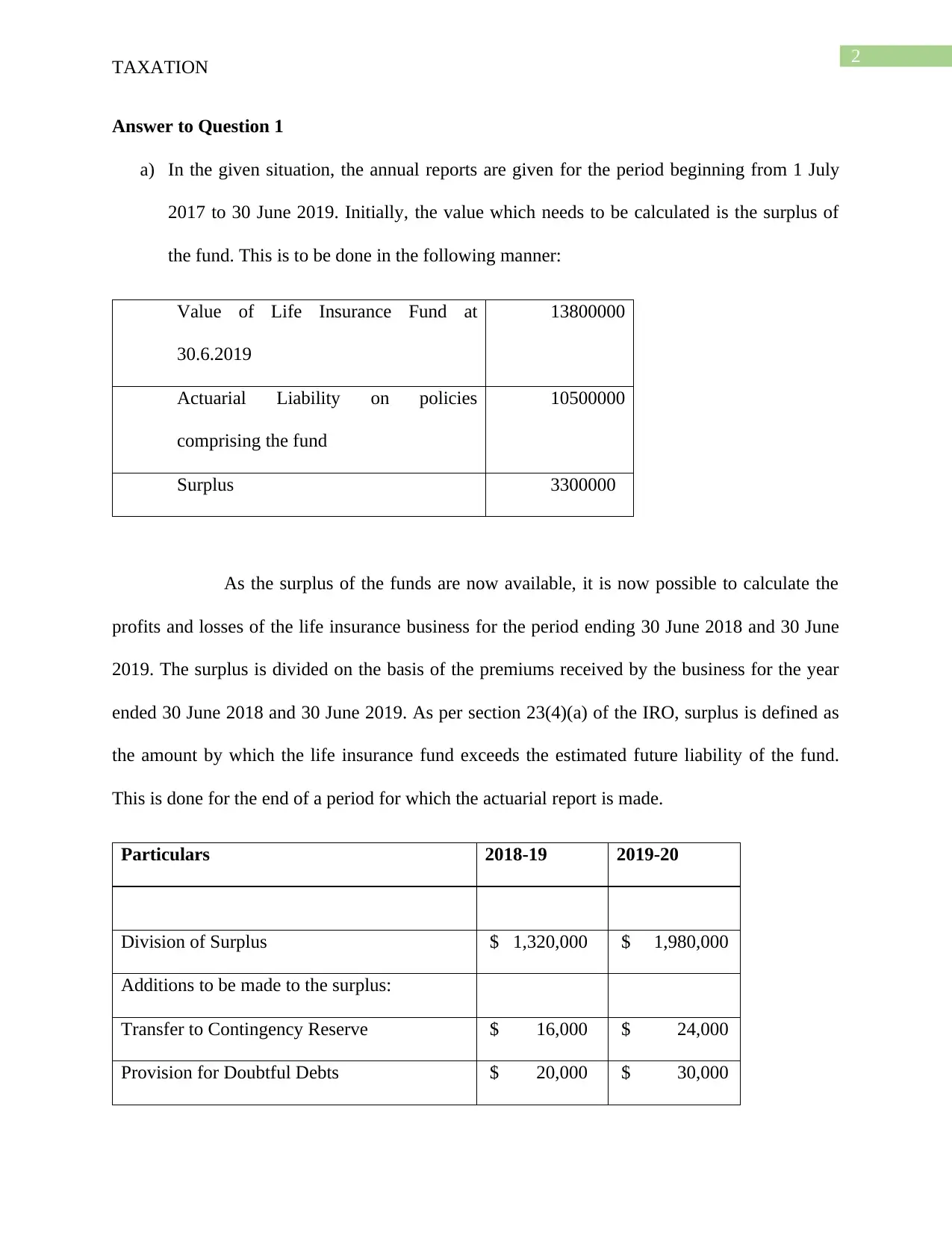
2
TAXATION
Answer to Question 1
a) In the given situation, the annual reports are given for the period beginning from 1 July
2017 to 30 June 2019. Initially, the value which needs to be calculated is the surplus of
the fund. This is to be done in the following manner:
Value of Life Insurance Fund at
30.6.2019
13800000
Actuarial Liability on policies
comprising the fund
10500000
Surplus 3300000
As the surplus of the funds are now available, it is now possible to calculate the
profits and losses of the life insurance business for the period ending 30 June 2018 and 30 June
2019. The surplus is divided on the basis of the premiums received by the business for the year
ended 30 June 2018 and 30 June 2019. As per section 23(4)(a) of the IRO, surplus is defined as
the amount by which the life insurance fund exceeds the estimated future liability of the fund.
This is done for the end of a period for which the actuarial report is made.
Particulars 2018-19 2019-20
Division of Surplus $ 1,320,000 $ 1,980,000
Additions to be made to the surplus:
Transfer to Contingency Reserve $ 16,000 $ 24,000
Provision for Doubtful Debts $ 20,000 $ 30,000
TAXATION
Answer to Question 1
a) In the given situation, the annual reports are given for the period beginning from 1 July
2017 to 30 June 2019. Initially, the value which needs to be calculated is the surplus of
the fund. This is to be done in the following manner:
Value of Life Insurance Fund at
30.6.2019
13800000
Actuarial Liability on policies
comprising the fund
10500000
Surplus 3300000
As the surplus of the funds are now available, it is now possible to calculate the
profits and losses of the life insurance business for the period ending 30 June 2018 and 30 June
2019. The surplus is divided on the basis of the premiums received by the business for the year
ended 30 June 2018 and 30 June 2019. As per section 23(4)(a) of the IRO, surplus is defined as
the amount by which the life insurance fund exceeds the estimated future liability of the fund.
This is done for the end of a period for which the actuarial report is made.
Particulars 2018-19 2019-20
Division of Surplus $ 1,320,000 $ 1,980,000
Additions to be made to the surplus:
Transfer to Contingency Reserve $ 16,000 $ 24,000
Provision for Doubtful Debts $ 20,000 $ 30,000
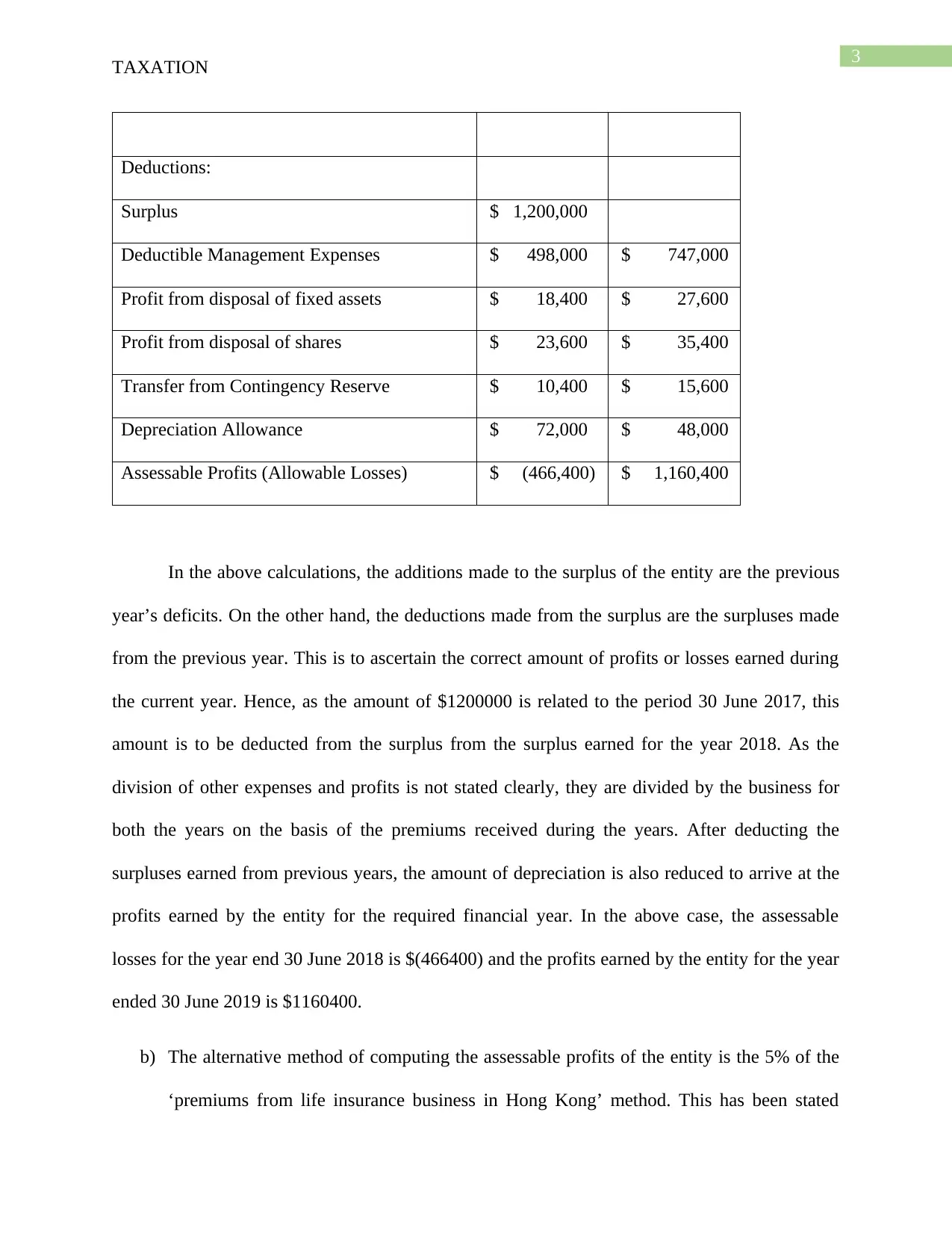
3
TAXATION
Deductions:
Surplus $ 1,200,000
Deductible Management Expenses $ 498,000 $ 747,000
Profit from disposal of fixed assets $ 18,400 $ 27,600
Profit from disposal of shares $ 23,600 $ 35,400
Transfer from Contingency Reserve $ 10,400 $ 15,600
Depreciation Allowance $ 72,000 $ 48,000
Assessable Profits (Allowable Losses) $ (466,400) $ 1,160,400
In the above calculations, the additions made to the surplus of the entity are the previous
year’s deficits. On the other hand, the deductions made from the surplus are the surpluses made
from the previous year. This is to ascertain the correct amount of profits or losses earned during
the current year. Hence, as the amount of $1200000 is related to the period 30 June 2017, this
amount is to be deducted from the surplus from the surplus earned for the year 2018. As the
division of other expenses and profits is not stated clearly, they are divided by the business for
both the years on the basis of the premiums received during the years. After deducting the
surpluses earned from previous years, the amount of depreciation is also reduced to arrive at the
profits earned by the entity for the required financial year. In the above case, the assessable
losses for the year end 30 June 2018 is $(466400) and the profits earned by the entity for the year
ended 30 June 2019 is $1160400.
b) The alternative method of computing the assessable profits of the entity is the 5% of the
‘premiums from life insurance business in Hong Kong’ method. This has been stated
TAXATION
Deductions:
Surplus $ 1,200,000
Deductible Management Expenses $ 498,000 $ 747,000
Profit from disposal of fixed assets $ 18,400 $ 27,600
Profit from disposal of shares $ 23,600 $ 35,400
Transfer from Contingency Reserve $ 10,400 $ 15,600
Depreciation Allowance $ 72,000 $ 48,000
Assessable Profits (Allowable Losses) $ (466,400) $ 1,160,400
In the above calculations, the additions made to the surplus of the entity are the previous
year’s deficits. On the other hand, the deductions made from the surplus are the surpluses made
from the previous year. This is to ascertain the correct amount of profits or losses earned during
the current year. Hence, as the amount of $1200000 is related to the period 30 June 2017, this
amount is to be deducted from the surplus from the surplus earned for the year 2018. As the
division of other expenses and profits is not stated clearly, they are divided by the business for
both the years on the basis of the premiums received during the years. After deducting the
surpluses earned from previous years, the amount of depreciation is also reduced to arrive at the
profits earned by the entity for the required financial year. In the above case, the assessable
losses for the year end 30 June 2018 is $(466400) and the profits earned by the entity for the year
ended 30 June 2019 is $1160400.
b) The alternative method of computing the assessable profits of the entity is the 5% of the
‘premiums from life insurance business in Hong Kong’ method. This has been stated
Secure Best Marks with AI Grader
Need help grading? Try our AI Grader for instant feedback on your assignments.
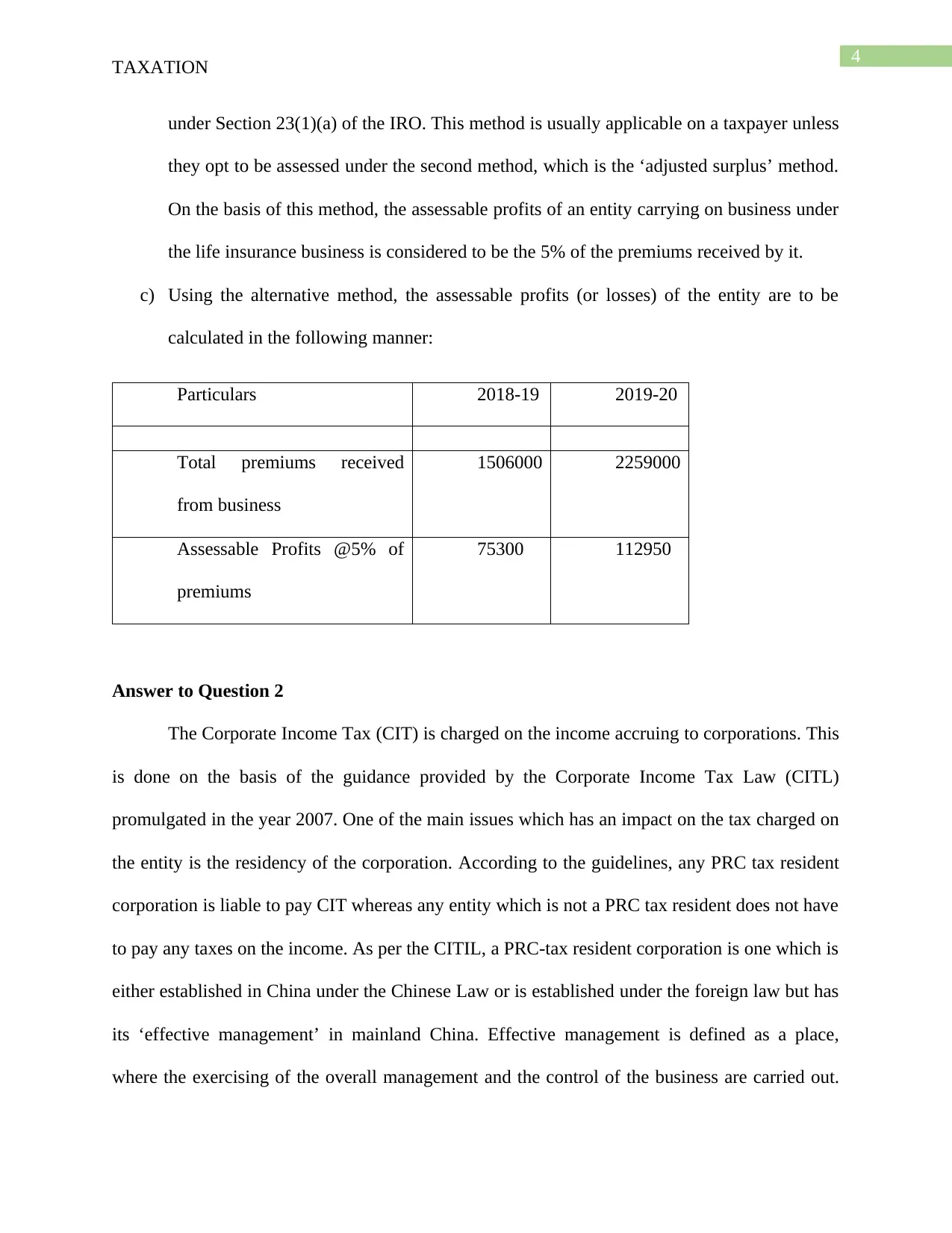
4
TAXATION
under Section 23(1)(a) of the IRO. This method is usually applicable on a taxpayer unless
they opt to be assessed under the second method, which is the ‘adjusted surplus’ method.
On the basis of this method, the assessable profits of an entity carrying on business under
the life insurance business is considered to be the 5% of the premiums received by it.
c) Using the alternative method, the assessable profits (or losses) of the entity are to be
calculated in the following manner:
Particulars 2018-19 2019-20
Total premiums received
from business
1506000 2259000
Assessable Profits @5% of
premiums
75300 112950
Answer to Question 2
The Corporate Income Tax (CIT) is charged on the income accruing to corporations. This
is done on the basis of the guidance provided by the Corporate Income Tax Law (CITL)
promulgated in the year 2007. One of the main issues which has an impact on the tax charged on
the entity is the residency of the corporation. According to the guidelines, any PRC tax resident
corporation is liable to pay CIT whereas any entity which is not a PRC tax resident does not have
to pay any taxes on the income. As per the CITIL, a PRC-tax resident corporation is one which is
either established in China under the Chinese Law or is established under the foreign law but has
its ‘effective management’ in mainland China. Effective management is defined as a place,
where the exercising of the overall management and the control of the business are carried out.
TAXATION
under Section 23(1)(a) of the IRO. This method is usually applicable on a taxpayer unless
they opt to be assessed under the second method, which is the ‘adjusted surplus’ method.
On the basis of this method, the assessable profits of an entity carrying on business under
the life insurance business is considered to be the 5% of the premiums received by it.
c) Using the alternative method, the assessable profits (or losses) of the entity are to be
calculated in the following manner:
Particulars 2018-19 2019-20
Total premiums received
from business
1506000 2259000
Assessable Profits @5% of
premiums
75300 112950
Answer to Question 2
The Corporate Income Tax (CIT) is charged on the income accruing to corporations. This
is done on the basis of the guidance provided by the Corporate Income Tax Law (CITL)
promulgated in the year 2007. One of the main issues which has an impact on the tax charged on
the entity is the residency of the corporation. According to the guidelines, any PRC tax resident
corporation is liable to pay CIT whereas any entity which is not a PRC tax resident does not have
to pay any taxes on the income. As per the CITIL, a PRC-tax resident corporation is one which is
either established in China under the Chinese Law or is established under the foreign law but has
its ‘effective management’ in mainland China. Effective management is defined as a place,
where the exercising of the overall management and the control of the business are carried out.
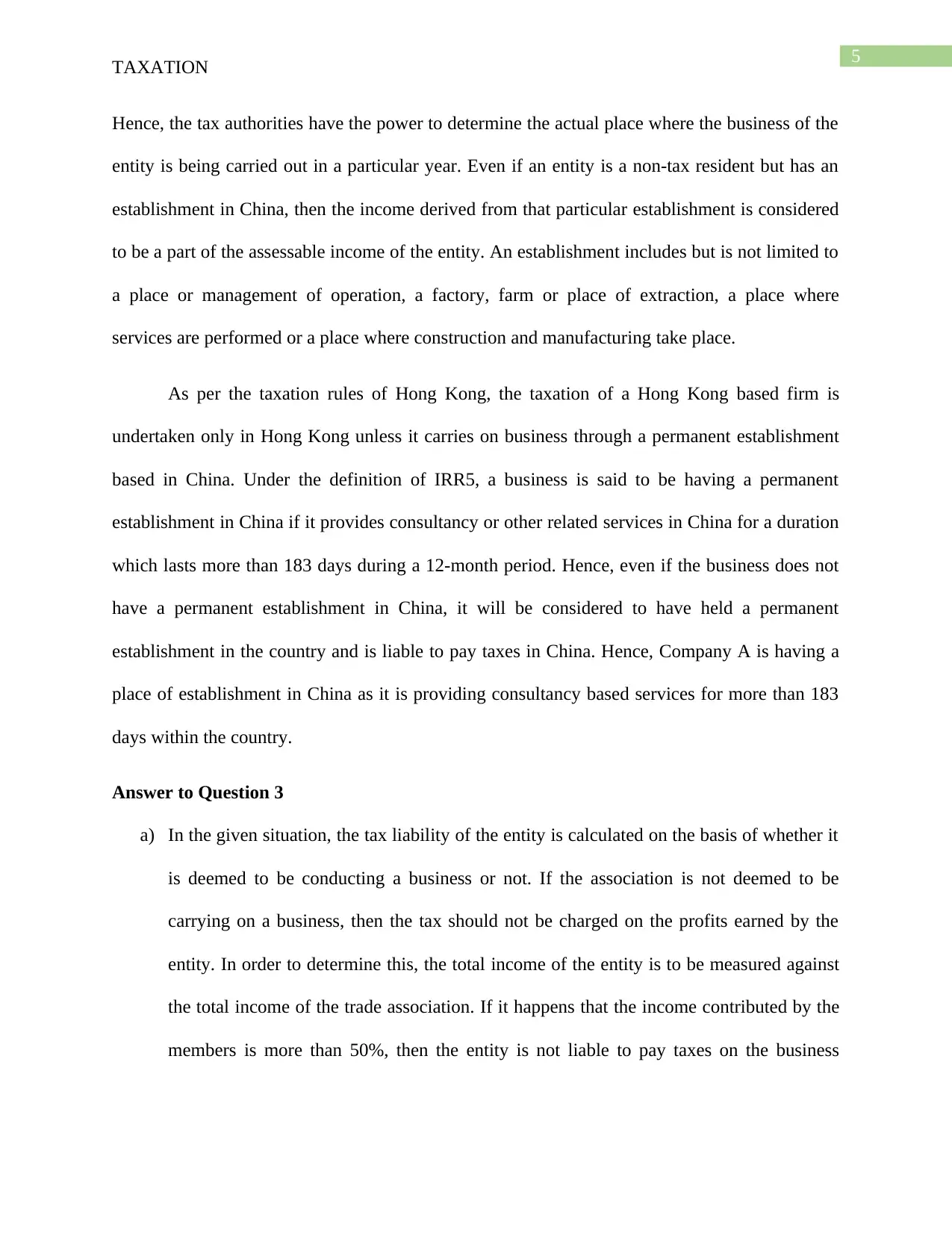
5
TAXATION
Hence, the tax authorities have the power to determine the actual place where the business of the
entity is being carried out in a particular year. Even if an entity is a non-tax resident but has an
establishment in China, then the income derived from that particular establishment is considered
to be a part of the assessable income of the entity. An establishment includes but is not limited to
a place or management of operation, a factory, farm or place of extraction, a place where
services are performed or a place where construction and manufacturing take place.
As per the taxation rules of Hong Kong, the taxation of a Hong Kong based firm is
undertaken only in Hong Kong unless it carries on business through a permanent establishment
based in China. Under the definition of IRR5, a business is said to be having a permanent
establishment in China if it provides consultancy or other related services in China for a duration
which lasts more than 183 days during a 12-month period. Hence, even if the business does not
have a permanent establishment in China, it will be considered to have held a permanent
establishment in the country and is liable to pay taxes in China. Hence, Company A is having a
place of establishment in China as it is providing consultancy based services for more than 183
days within the country.
Answer to Question 3
a) In the given situation, the tax liability of the entity is calculated on the basis of whether it
is deemed to be conducting a business or not. If the association is not deemed to be
carrying on a business, then the tax should not be charged on the profits earned by the
entity. In order to determine this, the total income of the entity is to be measured against
the total income of the trade association. If it happens that the income contributed by the
members is more than 50%, then the entity is not liable to pay taxes on the business
TAXATION
Hence, the tax authorities have the power to determine the actual place where the business of the
entity is being carried out in a particular year. Even if an entity is a non-tax resident but has an
establishment in China, then the income derived from that particular establishment is considered
to be a part of the assessable income of the entity. An establishment includes but is not limited to
a place or management of operation, a factory, farm or place of extraction, a place where
services are performed or a place where construction and manufacturing take place.
As per the taxation rules of Hong Kong, the taxation of a Hong Kong based firm is
undertaken only in Hong Kong unless it carries on business through a permanent establishment
based in China. Under the definition of IRR5, a business is said to be having a permanent
establishment in China if it provides consultancy or other related services in China for a duration
which lasts more than 183 days during a 12-month period. Hence, even if the business does not
have a permanent establishment in China, it will be considered to have held a permanent
establishment in the country and is liable to pay taxes in China. Hence, Company A is having a
place of establishment in China as it is providing consultancy based services for more than 183
days within the country.
Answer to Question 3
a) In the given situation, the tax liability of the entity is calculated on the basis of whether it
is deemed to be conducting a business or not. If the association is not deemed to be
carrying on a business, then the tax should not be charged on the profits earned by the
entity. In order to determine this, the total income of the entity is to be measured against
the total income of the trade association. If it happens that the income contributed by the
members is more than 50%, then the entity is not liable to pay taxes on the business
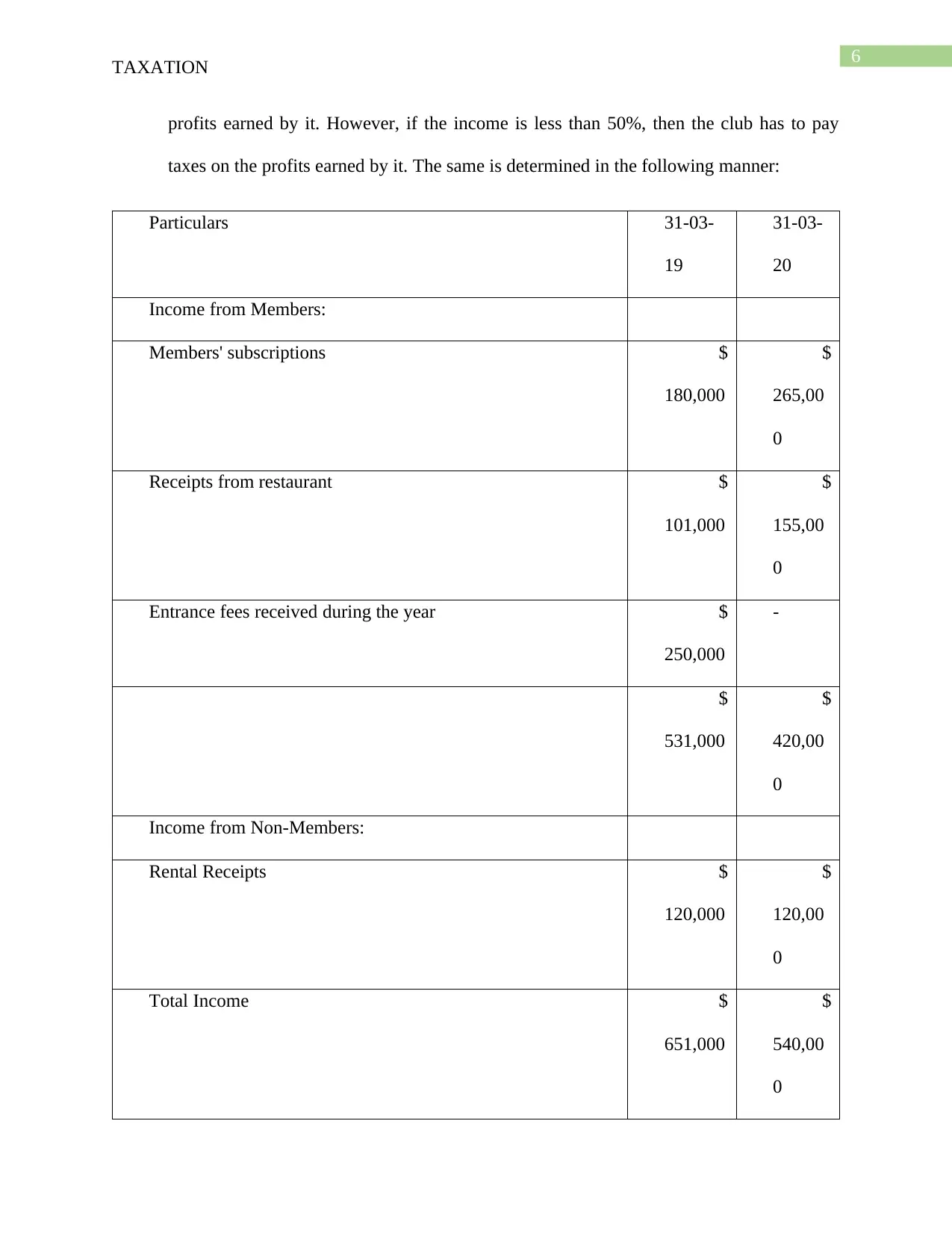
6
TAXATION
profits earned by it. However, if the income is less than 50%, then the club has to pay
taxes on the profits earned by it. The same is determined in the following manner:
Particulars 31-03-
19
31-03-
20
Income from Members:
Members' subscriptions $
180,000
$
265,00
0
Receipts from restaurant $
101,000
$
155,00
0
Entrance fees received during the year $
250,000
-
$
531,000
$
420,00
0
Income from Non-Members:
Rental Receipts $
120,000
$
120,00
0
Total Income $
651,000
$
540,00
0
TAXATION
profits earned by it. However, if the income is less than 50%, then the club has to pay
taxes on the profits earned by it. The same is determined in the following manner:
Particulars 31-03-
19
31-03-
20
Income from Members:
Members' subscriptions $
180,000
$
265,00
0
Receipts from restaurant $
101,000
$
155,00
0
Entrance fees received during the year $
250,000
-
$
531,000
$
420,00
0
Income from Non-Members:
Rental Receipts $
120,000
$
120,00
0
Total Income $
651,000
$
540,00
0
Paraphrase This Document
Need a fresh take? Get an instant paraphrase of this document with our AI Paraphraser
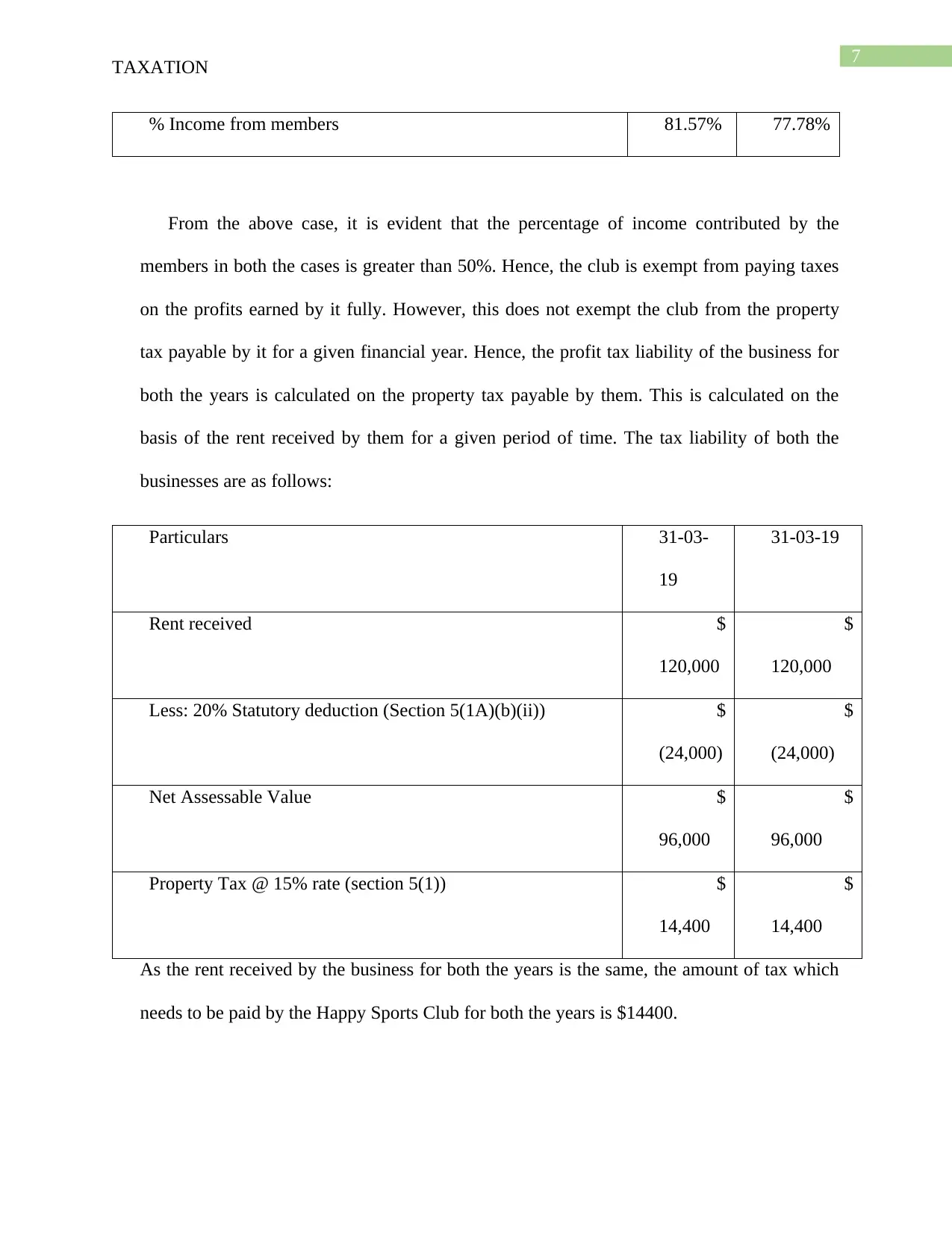
7
TAXATION
% Income from members 81.57% 77.78%
From the above case, it is evident that the percentage of income contributed by the
members in both the cases is greater than 50%. Hence, the club is exempt from paying taxes
on the profits earned by it fully. However, this does not exempt the club from the property
tax payable by it for a given financial year. Hence, the profit tax liability of the business for
both the years is calculated on the property tax payable by them. This is calculated on the
basis of the rent received by them for a given period of time. The tax liability of both the
businesses are as follows:
Particulars 31-03-
19
31-03-19
Rent received $
120,000
$
120,000
Less: 20% Statutory deduction (Section 5(1A)(b)(ii)) $
(24,000)
$
(24,000)
Net Assessable Value $
96,000
$
96,000
Property Tax @ 15% rate (section 5(1)) $
14,400
$
14,400
As the rent received by the business for both the years is the same, the amount of tax which
needs to be paid by the Happy Sports Club for both the years is $14400.
TAXATION
% Income from members 81.57% 77.78%
From the above case, it is evident that the percentage of income contributed by the
members in both the cases is greater than 50%. Hence, the club is exempt from paying taxes
on the profits earned by it fully. However, this does not exempt the club from the property
tax payable by it for a given financial year. Hence, the profit tax liability of the business for
both the years is calculated on the property tax payable by them. This is calculated on the
basis of the rent received by them for a given period of time. The tax liability of both the
businesses are as follows:
Particulars 31-03-
19
31-03-19
Rent received $
120,000
$
120,000
Less: 20% Statutory deduction (Section 5(1A)(b)(ii)) $
(24,000)
$
(24,000)
Net Assessable Value $
96,000
$
96,000
Property Tax @ 15% rate (section 5(1)) $
14,400
$
14,400
As the rent received by the business for both the years is the same, the amount of tax which
needs to be paid by the Happy Sports Club for both the years is $14400.
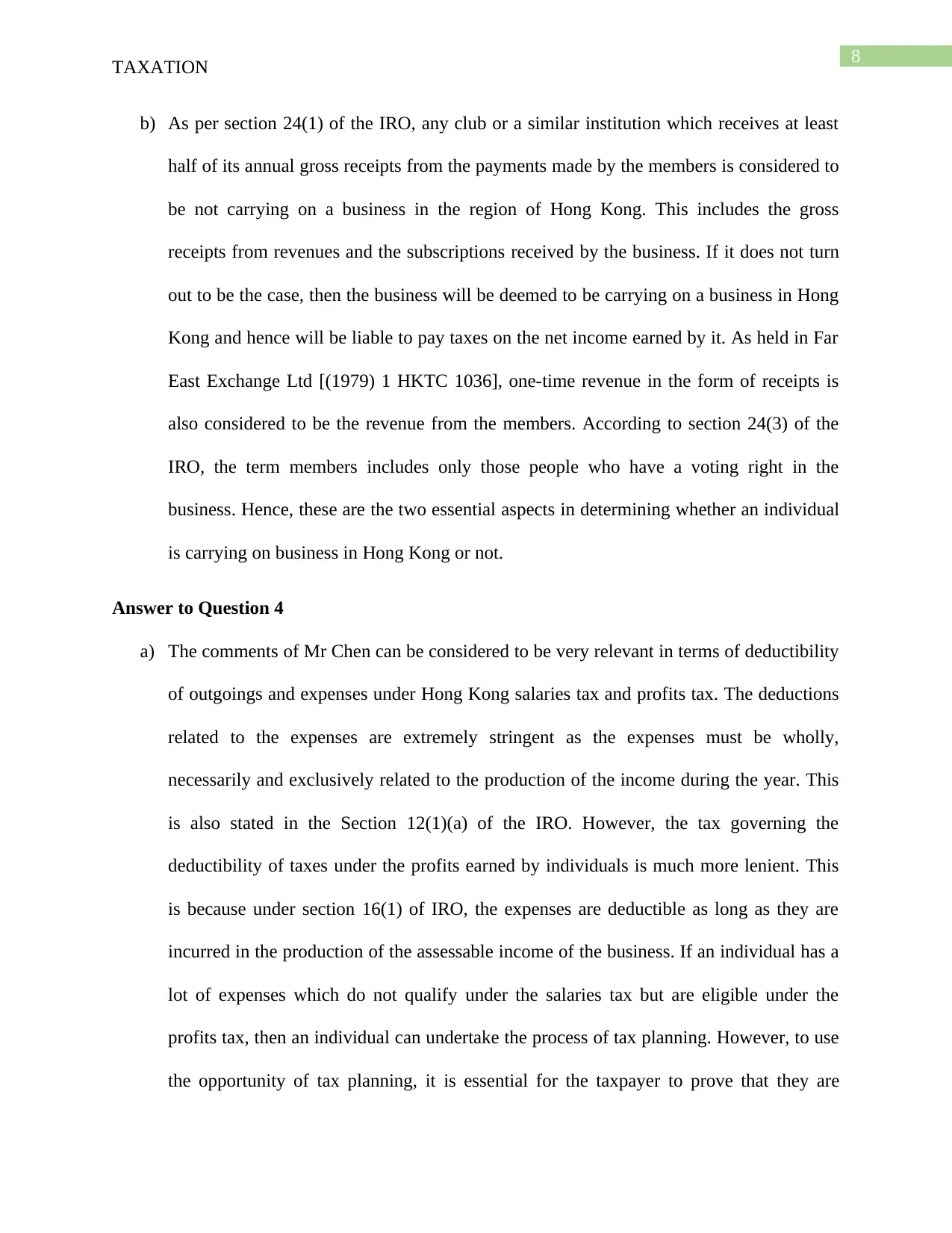
8
TAXATION
b) As per section 24(1) of the IRO, any club or a similar institution which receives at least
half of its annual gross receipts from the payments made by the members is considered to
be not carrying on a business in the region of Hong Kong. This includes the gross
receipts from revenues and the subscriptions received by the business. If it does not turn
out to be the case, then the business will be deemed to be carrying on a business in Hong
Kong and hence will be liable to pay taxes on the net income earned by it. As held in Far
East Exchange Ltd [(1979) 1 HKTC 1036], one-time revenue in the form of receipts is
also considered to be the revenue from the members. According to section 24(3) of the
IRO, the term members includes only those people who have a voting right in the
business. Hence, these are the two essential aspects in determining whether an individual
is carrying on business in Hong Kong or not.
Answer to Question 4
a) The comments of Mr Chen can be considered to be very relevant in terms of deductibility
of outgoings and expenses under Hong Kong salaries tax and profits tax. The deductions
related to the expenses are extremely stringent as the expenses must be wholly,
necessarily and exclusively related to the production of the income during the year. This
is also stated in the Section 12(1)(a) of the IRO. However, the tax governing the
deductibility of taxes under the profits earned by individuals is much more lenient. This
is because under section 16(1) of IRO, the expenses are deductible as long as they are
incurred in the production of the assessable income of the business. If an individual has a
lot of expenses which do not qualify under the salaries tax but are eligible under the
profits tax, then an individual can undertake the process of tax planning. However, to use
the opportunity of tax planning, it is essential for the taxpayer to prove that they are
TAXATION
b) As per section 24(1) of the IRO, any club or a similar institution which receives at least
half of its annual gross receipts from the payments made by the members is considered to
be not carrying on a business in the region of Hong Kong. This includes the gross
receipts from revenues and the subscriptions received by the business. If it does not turn
out to be the case, then the business will be deemed to be carrying on a business in Hong
Kong and hence will be liable to pay taxes on the net income earned by it. As held in Far
East Exchange Ltd [(1979) 1 HKTC 1036], one-time revenue in the form of receipts is
also considered to be the revenue from the members. According to section 24(3) of the
IRO, the term members includes only those people who have a voting right in the
business. Hence, these are the two essential aspects in determining whether an individual
is carrying on business in Hong Kong or not.
Answer to Question 4
a) The comments of Mr Chen can be considered to be very relevant in terms of deductibility
of outgoings and expenses under Hong Kong salaries tax and profits tax. The deductions
related to the expenses are extremely stringent as the expenses must be wholly,
necessarily and exclusively related to the production of the income during the year. This
is also stated in the Section 12(1)(a) of the IRO. However, the tax governing the
deductibility of taxes under the profits earned by individuals is much more lenient. This
is because under section 16(1) of IRO, the expenses are deductible as long as they are
incurred in the production of the assessable income of the business. If an individual has a
lot of expenses which do not qualify under the salaries tax but are eligible under the
profits tax, then an individual can undertake the process of tax planning. However, to use
the opportunity of tax planning, it is essential for the taxpayer to prove that they are
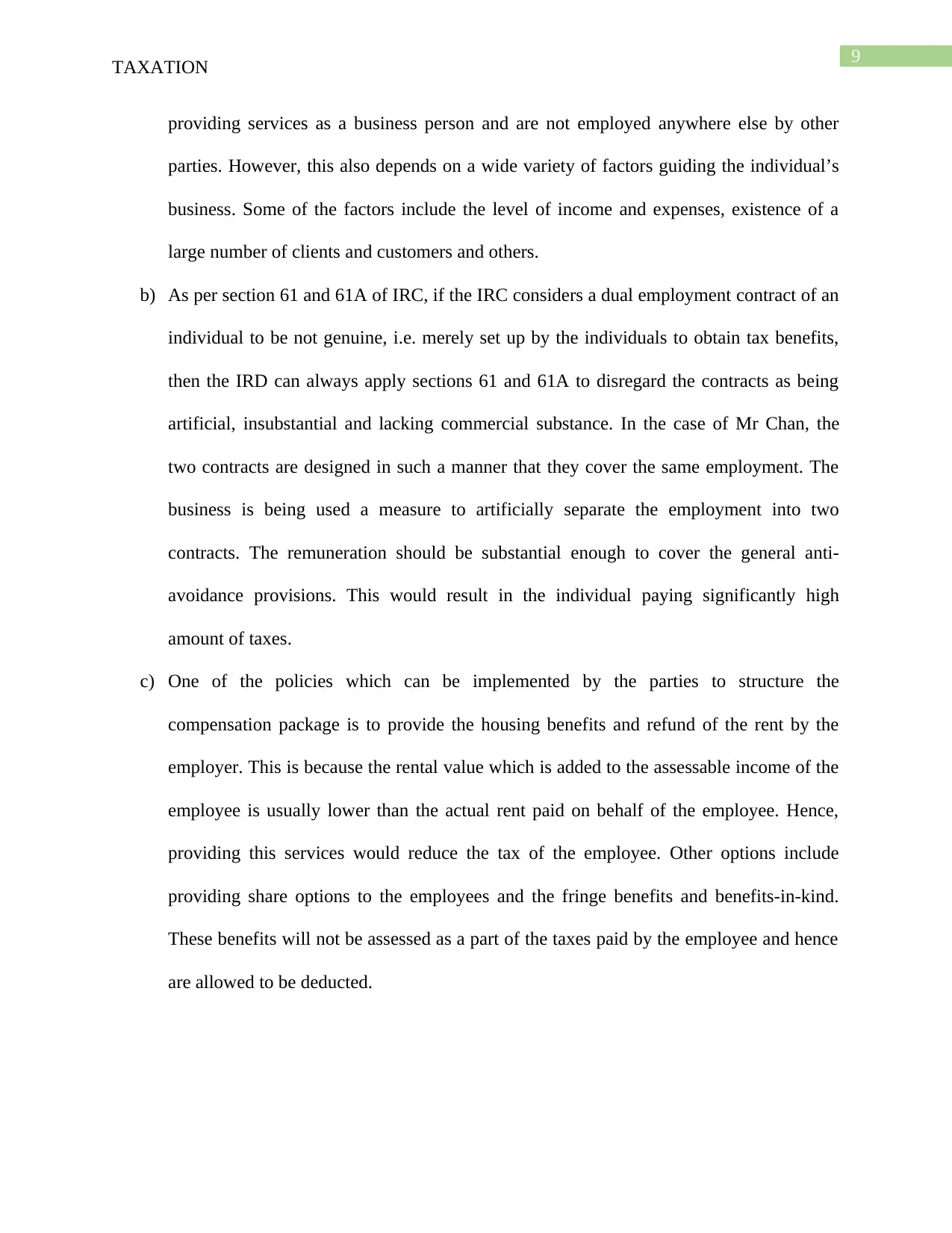
9
TAXATION
providing services as a business person and are not employed anywhere else by other
parties. However, this also depends on a wide variety of factors guiding the individual’s
business. Some of the factors include the level of income and expenses, existence of a
large number of clients and customers and others.
b) As per section 61 and 61A of IRC, if the IRC considers a dual employment contract of an
individual to be not genuine, i.e. merely set up by the individuals to obtain tax benefits,
then the IRD can always apply sections 61 and 61A to disregard the contracts as being
artificial, insubstantial and lacking commercial substance. In the case of Mr Chan, the
two contracts are designed in such a manner that they cover the same employment. The
business is being used a measure to artificially separate the employment into two
contracts. The remuneration should be substantial enough to cover the general anti-
avoidance provisions. This would result in the individual paying significantly high
amount of taxes.
c) One of the policies which can be implemented by the parties to structure the
compensation package is to provide the housing benefits and refund of the rent by the
employer. This is because the rental value which is added to the assessable income of the
employee is usually lower than the actual rent paid on behalf of the employee. Hence,
providing this services would reduce the tax of the employee. Other options include
providing share options to the employees and the fringe benefits and benefits-in-kind.
These benefits will not be assessed as a part of the taxes paid by the employee and hence
are allowed to be deducted.
TAXATION
providing services as a business person and are not employed anywhere else by other
parties. However, this also depends on a wide variety of factors guiding the individual’s
business. Some of the factors include the level of income and expenses, existence of a
large number of clients and customers and others.
b) As per section 61 and 61A of IRC, if the IRC considers a dual employment contract of an
individual to be not genuine, i.e. merely set up by the individuals to obtain tax benefits,
then the IRD can always apply sections 61 and 61A to disregard the contracts as being
artificial, insubstantial and lacking commercial substance. In the case of Mr Chan, the
two contracts are designed in such a manner that they cover the same employment. The
business is being used a measure to artificially separate the employment into two
contracts. The remuneration should be substantial enough to cover the general anti-
avoidance provisions. This would result in the individual paying significantly high
amount of taxes.
c) One of the policies which can be implemented by the parties to structure the
compensation package is to provide the housing benefits and refund of the rent by the
employer. This is because the rental value which is added to the assessable income of the
employee is usually lower than the actual rent paid on behalf of the employee. Hence,
providing this services would reduce the tax of the employee. Other options include
providing share options to the employees and the fringe benefits and benefits-in-kind.
These benefits will not be assessed as a part of the taxes paid by the employee and hence
are allowed to be deducted.
Secure Best Marks with AI Grader
Need help grading? Try our AI Grader for instant feedback on your assignments.

10
TAXATION
TAXATION
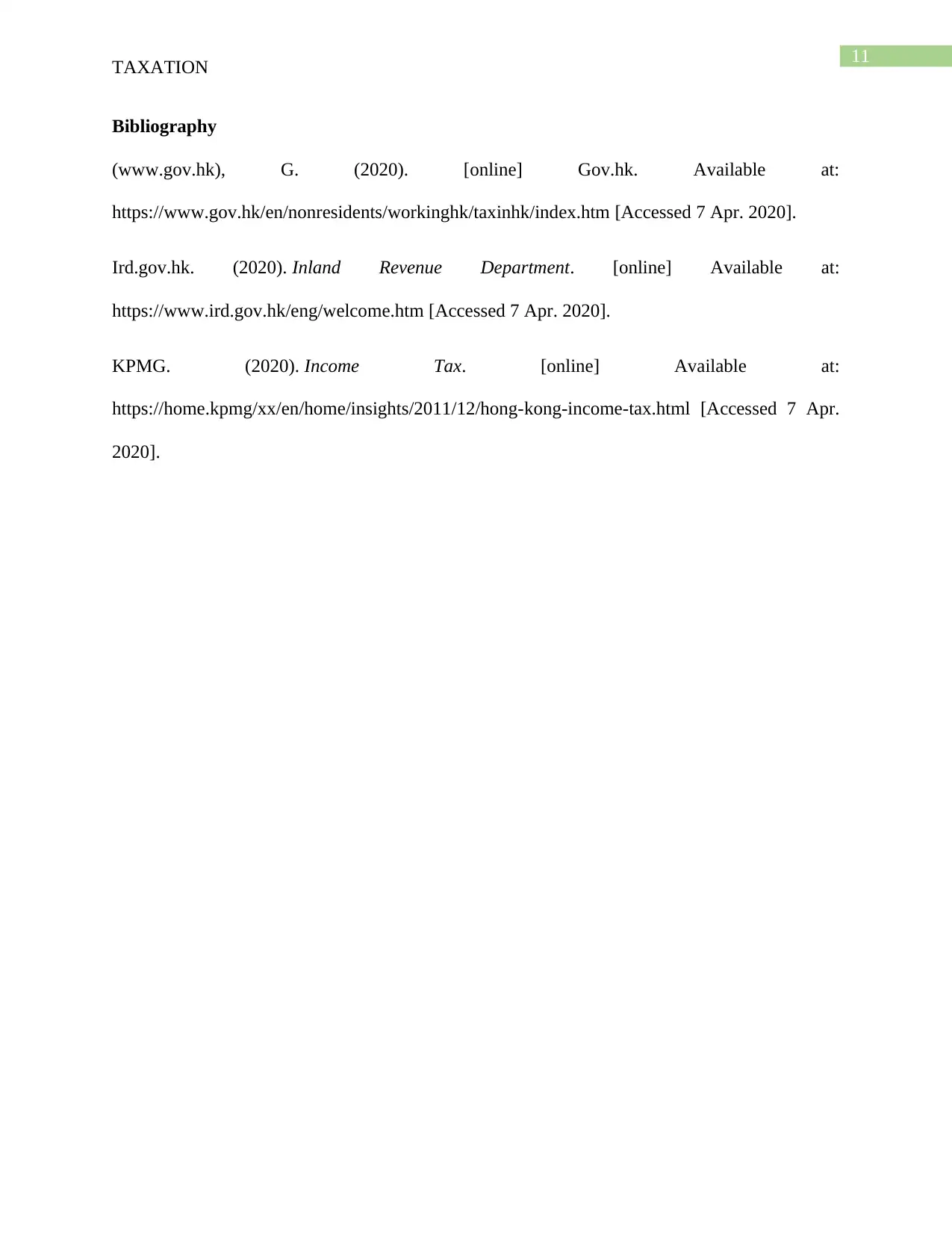
11
TAXATION
Bibliography
(www.gov.hk), G. (2020). [online] Gov.hk. Available at:
https://www.gov.hk/en/nonresidents/workinghk/taxinhk/index.htm [Accessed 7 Apr. 2020].
Ird.gov.hk. (2020). Inland Revenue Department. [online] Available at:
https://www.ird.gov.hk/eng/welcome.htm [Accessed 7 Apr. 2020].
KPMG. (2020). Income Tax. [online] Available at:
https://home.kpmg/xx/en/home/insights/2011/12/hong-kong-income-tax.html [Accessed 7 Apr.
2020].
TAXATION
Bibliography
(www.gov.hk), G. (2020). [online] Gov.hk. Available at:
https://www.gov.hk/en/nonresidents/workinghk/taxinhk/index.htm [Accessed 7 Apr. 2020].
Ird.gov.hk. (2020). Inland Revenue Department. [online] Available at:
https://www.ird.gov.hk/eng/welcome.htm [Accessed 7 Apr. 2020].
KPMG. (2020). Income Tax. [online] Available at:
https://home.kpmg/xx/en/home/insights/2011/12/hong-kong-income-tax.html [Accessed 7 Apr.
2020].
1 out of 12
Related Documents
Your All-in-One AI-Powered Toolkit for Academic Success.
+13062052269
info@desklib.com
Available 24*7 on WhatsApp / Email
![[object Object]](/_next/static/media/star-bottom.7253800d.svg)
Unlock your academic potential
© 2024 | Zucol Services PVT LTD | All rights reserved.





